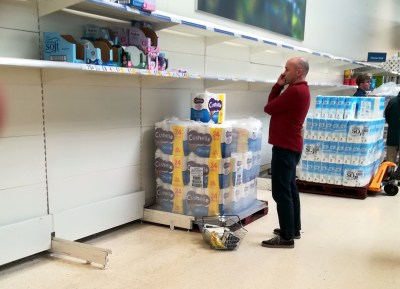As the world begins to slowly pull itself out of the economic effects of the pandemic, there’s one story that has been on our minds for the past couple of years, and it’s probably on yours too. The chip shortage born during those first months of the pandemic has remained with us despite the best efforts of the industry. Last year, pundits were predicting a return to normality in 2022, but will unexpected threats to production such as the war in Ukraine keep us chasing supplies? It’s time to delve into the root of the issue and get to the bottom of it for a Hackaday report.
The Chips Are Down

Going back to 2020, and as global economies abruptly slowed down in the face of stringent lockdowns it’s clear that both chipmakers and their customers hugely underestimated the effect that the pandemic would have on global demand for chips.
As production capacity was reduced or turned to other products in response to the changed conditions, it was soon obvious that the customers’ hunger for chips had not abated, resulting in a shortfall between supply and demand.
We’ve all experienced the chaos that ensued as the supply of popular varieties dried up almost overnight, and as fresh pandemic waves have broken around the world along with a crop of climate and geopolitical uncertainties it’s left many wondering whether the chip situation will ever be the same again.
Green Shoots In Idaho

Amidst all that gloom, there are some encouraging green shoots to be seen. While it’s perhaps not quite time to celebrate, there’s a possibility for some cautious optimism. This month brought the hope that Potato Semiconductor might be cutting the sod on a new production capacity for their ultra-fast digital logic in Idaho, and with other manufacturers following suit it could be that we’ll once again have all the chip capacity we can eat.
But the other side of the chip business coin lies with the customer: we all see the chip shortage from our own semi-insider perspective, but have the tastes of the general public returned towards chips? Early signs are that as consumer confidence returns there are encouraging trends in chip consumption taking root, so we’d be inclined to advise our readers to have cautious optimism. If all goes well, you’ll be having your chips by summer.
The prospects for a new dawn in chip production capacity in 2022 look rosy, but there’s a further snag on the horizon courtesy of the Russian invasion of Ukraine. Like so many industries in a globalised economy, the chip industry depends heavily on supplies, consumables, and machinery from beyond the borders of wherever the plants themselves may lie.
In the case of Ukraine there’s a particular raw material whose supply has been severely interrupted, and though we hope for a speedy resolution of the conflict and a consequent resumption of production, the knock-on effect on the production of chips in the rest of the world can not be underestimated. Despite the ramp-up in output led by Idaho, the production of chips globally still relies heavily on Ukrainian sunflower oil. There’s a possibility that an acceptable substitute might be found in canola oil, but it will remain to be seen whether the chip-eating consumers will notice the taste difference.
If you would like to help the people of Ukraine in their hour of need, here are some organisations working on the ground to whom you can donate.
Header image: Daniel Kraft, CC BY-SA 3.0.
















It wasn’t until the sunflower oil bit that I got the joke. Well done!
Thank you for a crisp explanation of the chip shortage.
The article was admittedly a little starchy in places but overall it satisfied my appetite.
I appreciate the journalism rooted in facts instead of another salty armchair analyst and spec-tater.
Why so salty. bro?
Shenanigans. I’m calling it.
There are various bags of chips in the kitchen, and I’m ordering Fritos this week.
The Canadian grocery store chain Loblaws is having problems with Frito-Lay, not willing to raise prices so Frito-Lay stopped supplying Loblaws. No word if they still carry Pepsi.
I wonder if you talk to Bob Lawblob, he’s in charge.
What I’ve been reading, there wasn’t a shortage per se but a huge demand ramp, they were increasing production 8% month on month still, no lack of output. Then other pundits saying we’re not gonna catch up for 3 years with the fab building. Cars in particular have gone from a handful of 8 bits running the engine and body systems to supercomputer class megacore requirement visual processing for their onboard AI driving assists.
Except for the fact that even basic gasoline vehicles are not shipping due to the lack of basic power MOSFETs whose production has no overlap with computer chips. These are not new exotic chips but the same old same old stuff that’s been in production for years. You can look on digikey and mouser and even the most basic and simple of semiconductors like diodes have crazy lead times. Again this stuff has zilch in common with computer chips. Your reasoning doesn’t hold up.
It’s a staircase of node sizes, with all the pushing and shoving to get the most profitable semis made, the least profitable fall off the bottom, if the top step is overcrowded it overflows to 2nd step down, which shoves some on the 2nd down to the 3rd and so on. Plus you need 6 mosfets for every high power chip likely so demand ramp is demand ramp all through the system.
It would be interesting to see what transistors (BJT) went up or down in demand and up or down in supply.
I still see so many old designs using transistors like the 2N2222, 2N3905, BC547 or even BC108 (or equivalents) most of these are from the 70’s and there’s a lot more suitable tranies for the task at lower prices now.
It’s just seems that when we stopped printing transistor specification tables for almost any transistor on the planet, and people forgot how to read them that designers go with the old and proven parts.
Now where did I put those OC71’s
But early on, a handful of devices were seen in hobby magazines. They were specified, so the hobby distributors carried them, which in turn got them used more. It was too much trouble ordering from industrial distributors.
Digikey started as a kit company, but then started carrying a limited line of parts.
Are you talking about eating chips in the car, or is this some kind of new in-vehicle biofuel conversion process, where the chips go in and fuel comes out?
Sunflower oil is irreplacable.
Quote: [crashsuit] “where the chips go in and fuel comes out”
Crunch, crunch, crunch, fart
It’s all nice and funny, but seriously: Browsing the websites of the big suppliers is freaking scary. There are quite a few IC that won’t be back before 06/23 or something. And prices have – of course – exploded, even on the chinese websites (where you might be unlucky and get fakes). This is not funny. :-/
You are at the very very end of the supply chain. Companies like apple pay extra and they go to the front of the line and they get their chips and you will continue to get none until the pipeline fills. This is why apple is still shipping while the rest of us are stuck. This is also why paying more is a good thing.
They aren’t just paying more to jump the queue – the big manufacturers are actually buying up the global supply of fabrication machines for their own use, denying it to the shared fabs where much of the global production happens.
https://www.crowdsupply.com/sutajio-kosagi/precursor/updates/more-supply-chain-issues-surprise-edition-the-good-the-bad-and-the-ugly
@X said: “You are at the very very end of the supply chain. Companies like apple pay extra and they go to the front of the line and they get their chips and you will continue to get none until the pipeline fills. This is why apple is still shipping while the rest of us are stuck. This is also why paying more is a good thing.”
Being forced to pay more is never a good thing. If the manufacturer pays more, YOU pay more!
This is what happens if you let dumb AI’s generate Hackaday articles.
I take that as a complement.
On that note, did you know that Coles Law is a corollary of Poes Law?
So there was this old sea dog, Captain Cole, who’d retired inland, and began to miss the smell of the salt air, so he takes a day trip out to a fishing port, one of those cute old towns and has a great time just strolling around the harbor, just taking in the sights and smell. Of course he works up an appetite, so goes into a small restaurant, it don’t look so great, but he’s old and doesn’t feel like walking much further. He orders a plate of cod and chips and to his great disappointment, it’s the worst he’s even had, leathery batter, fries that are somehow both soggy, yet crunchy in the middle and as the proprietor hauls up to his table to ask if it’s okay and he needs anything else, he put on his most sarcastic tone and says “Arrr, the only thing to improve this would be some thinly sliced raw cabbage.” and thus Coleslaw was born.
The full complement? May I compliment you on your speeling.
I still haven’t been able to decide whether this article is about potato chips and such or IC’s. I know for a long time I couldn’t buy a bag or Fritos corn chips and the local store shelves were getting pretty rough looking. Now I do know I have been having issues acquiring a lot of electronic components for the last 2 years. Engineers are looking for ways to design circuits using less difficult components to build with but IMHO, that’s going to be a really tough job.
potatosemi has a similar issue.
Once potato batteries happened, making potato semiconductors was the logical next step.
Potato Semiconductor is a real thing:
http://potatosemi.com/
“Engineers are looking for ways to design circuits using less difficult components to build with but IMHO, that’s going to be a really tough job.”
Good in a way in that it allows one to exercise their design skills. Keeps one from getting stagnant, and could end up as a good “hack”.
This article neglects to mention that California, Texas, and Mexico have also invested heavily in alternative chip technology.
Funny thing is, we do actually have a thriving semiconductor industry here in Idaho.
That’s the same photo as 2020’s april fools day article!
Said Jenny in a caption that is notably absent now: “This is the very last of the toilet paper in my local supermarket, on the 8th of March.”
Indeed it is. Cheap, me. Well, I have the rights on it, so why not.
I took it at the Tesco in Bicester on 2020-03-08.
I figured it was a photo you had taken. I was just so proud of myself for recognizing it!